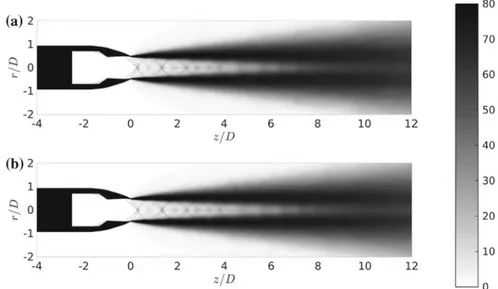Large Eddy Simulation of Highly Compressible Jets with Tripped Boundary Layers
Texte intégral
Figure

![Fig. 5 Radial profile of mean axial velocity (a, c) and 2-D turbulent kinetic energy (b, d) at a, b x = D and c, d x = 5D; experimental data (bullets) [ 6 ], baseline case (black line), case 1 (dashed line) and case 2 (grey line)](https://thumb-eu.123doks.com/thumbv2/123doknet/2962618.81625/5.659.135.521.87.395/radial-profile-velocity-turbulent-kinetic-experimental-bullets-baseline.webp)

Documents relatifs
PACE4 Is Responsible for the Cell Surface Furin-independent Maturation of IRB— ProIR proteolytic maturation was analyzed in LoVo cells overexpressing the PCs that exhibit a
Some properties of shock noise generated by underexpanded round jets issued from a convergent nozzle are briefly introduced in this paper. They are illustrated by experimental
Figure 8 shows the maximum envelope amplitude of the stacked signals as a function of reduction velocity (slowness) and profile azimuth, for frequency band FB2.. This
According to the experimental results of Zaman 35–37 and more recent numerical observations, 26, 38, 39 jet flow development and noise radiation vary with the turbulence level in
R., and Edgington-Mitchell, D., “Impact of coherence decay on wavepacket models for broadband shock-associated noise in supersonic jets,” Journal of Fluid Mechanics , Vol.. R.,
In their model, Ray and Lele (2007) also made a comparable simplification, whereby far-field pressure predictions for only the first three azimuthal modes were combined and scaled
maximum envelope amplitude of the stacked signals as a function of reduction velocity (slowness) and profile azimuth, for frequency band FB2.. This calculation corresponds to the